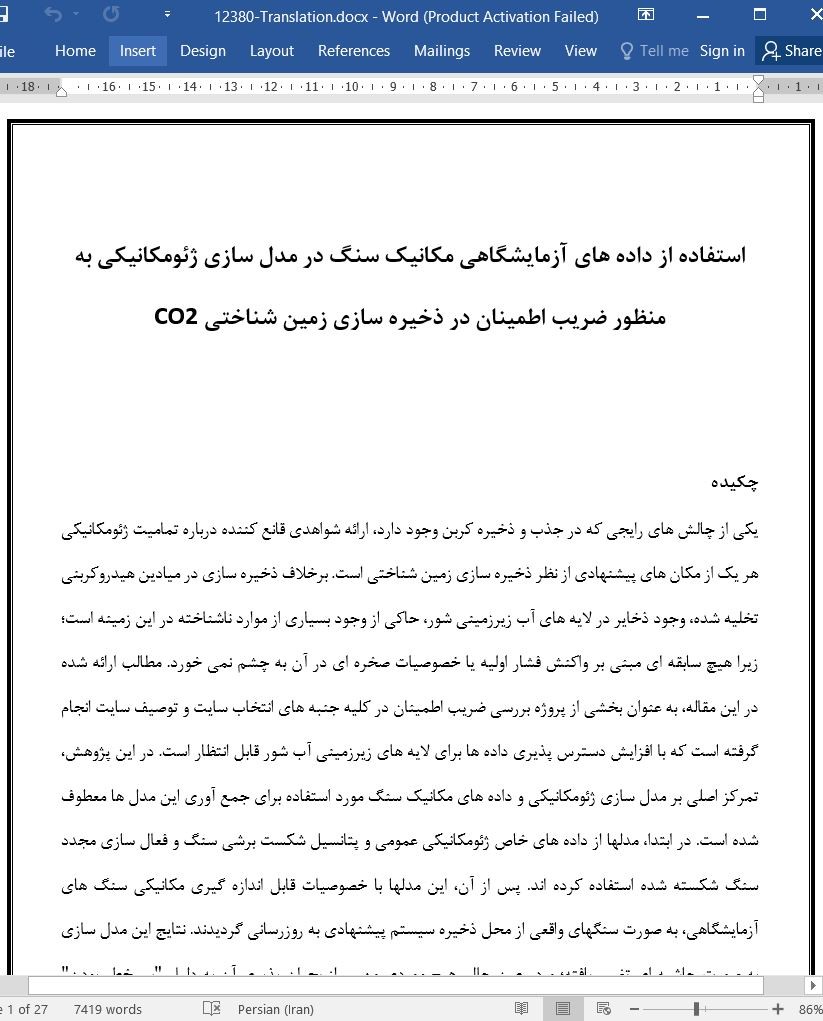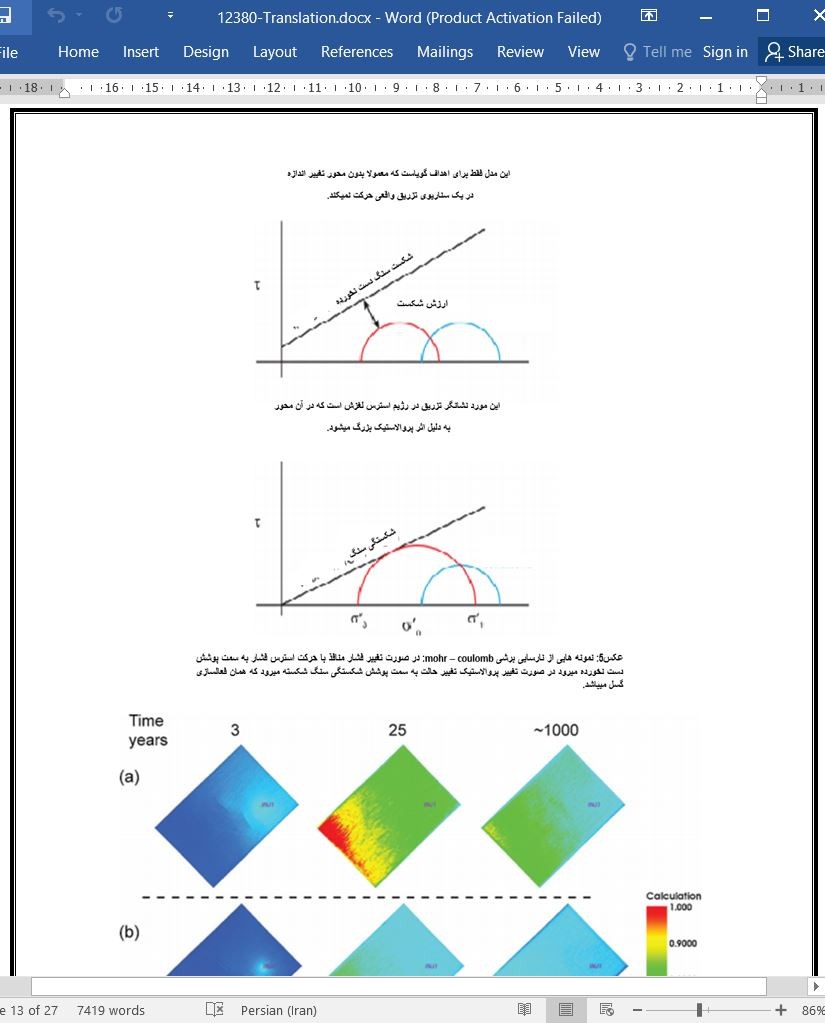
استفاده از داده های آزمایشگاهی مکانیک سنگ در مدل سازی ژئومکانیکی به منظور ضریب اطمینان
چکیده
یکی از چالش های رایجی که در جذب و ذخیره کربن وجود دارد، ارائه شواهدی قانع کننده درباره تمامیت ژئومکانیکی هر یک از مکان های پیشنهادی از نظر ذخیره سازی زمین شناختی است. برخلاف ذخیره سازی در میادین هیدروکربنی تخلیه شده، وجود ذخایر در لایه های آب زیرزمینی شور، حاکی از وجود بسیاری از موارد ناشناخته در این زمینه است؛ زیرا هیچ سابقه ای مبنی بر واکنش فشار اولیه یا خصوصیات صخره ای در آن به چشم نمی خورد. مطالب ارائه شده در این مقاله، به عنوان بخشی از پروژه بررسی ضریب اطمینان در کلیه جنبه های انتخاب سایت و توصیف سایت انجام گرفته است که با افزایش دسترس پذیری داده ها برای لایه های زیرزمینی آب شور قابل انتظار است. در این پژوهش، تمرکز اصلی بر مدل سازی ژئومکانیکی و داده های مکانیک سنگ مورد استفاده برای جمع آوری این مدل ها معطوف شده است. در ابتدا، مدلها از داده های خاص ژئومکانیکی عمومی و پتانسیل شکست برشی سنگ و فعال سازی مجدد سنگ شکسته شده استفاده کرده اند. پس از آن، این مدلها با خصوصیات قابل اندازه گیری مکانیکی سنگ های آزمایشگاهی، به صورت سنگهای واقعی از محل ذخیره سیستم پیشنهادی به روزرسانی گردیدند. نتایج این مدل سازی به صورت حاشیه ای تغییر یافته؛ و در عین حال، هیچ موردی مهمی از بحران پذیری آن به دلیل "بی خطر بودن" نسبی از نظر ژئومکانیک محل ذخیره سازی، شناسایی نشده است.
1. مقدمه
جذب و ذخیره کربن (CCS) با چالش های بسیاری روبرو است که از جمله آنها می توان به اعتبارسنجی ایمنی و تعیین میزان خطرات مرتبط با ذخیره سازی زمین شناختی هر عنصر اشاره کرد. برای تعیین کمیت این خطرات، به درک کاملی از فرآیندهای شیمیایی و فیزیکی زیرسطحی درگیر در کنار یکدیگر و قابلیت شبیه سازی آنها برای ارزیابی و اهداف ذخیره سازی، نیاز داریم. اگرچه می توان بسیاری از فعالیتهای تولید / ذخیره سازی جغرافیایی و طبیعی زیرزمینی را جمع آوری کرد ، اعتبارسنجی ذخیره سازی زمین شناختی CO2، نیازهای مورد نظر را در صدر رشته های مرتبط با این موضوع قرار می دهد. این امر به خصوص در زمینه شبیه سازی مخزن، که در آن مدل سازی هیدروژئولوژیکی مناسبی برای مخازن هیدروکربن طراحی می شود ، باید توام با مدل سازی هر دو فرآیند ژئوشیمیایی و ژئومکانیکی در نظر گرفته شود. در بسیاری از پروژه های ذخیره سازی زمین شناختی CO2، روش متداولی کخ به بررسی این فرایندها می پردازد، روشی مستقل است. با این حال آنها ذاتاً به یکدیگر مرتبط هستند و هدف اصلی در شبیه سازی مخزن ذخیره سازی زمین شناختی CO2، باید توسعه آن دسته از روش ها و تکنیک های مدل سازی باشد که وابستگی متقابل کلیه فرآیندهای درگیر از جمله اثرات جریانی، حرارتی، ژئوشیمیایی و ژئومکانیکی را ثبت می نماید.
6.نتیجه گیری
اثبات یکپارچگی ساختاری ژئومکانیکی سایت های ذخیره سازی یک عامل مهم در استقرار موفقیت آمیز ccs خواهد بود. با توجه به منحصر به فرد بودن سایتهای ذخیره بالقوه لازم است این مورد بصورت موردی ارزیابی شود. شبیه سازی مخزن مدل سازی ژئومکانیکی یکی از تکنیک های مورد استفاده برای دستیابی به این هدف خواهد بود. روش های شبیه سازی که در حال حاضر در استخراج هیدرو کربن مورد استفاده قرار میگیرند ابزار های مناسبی را ارائه میدهند اما اینها برای کار ذخیره سازی زمین شناسی co2 به همراه داده های نمونه سنگی خاص سایت از ویژگی های ژئوشیمیایی خاص سایت اندازه گیری نیاز است.
Abstract
One of the many challenges facing carbon capture and storage will be to provide convincing evidence of the geomechanical integrity of any proposed geological storage site. Contrary to storage in depleted hydrocarbon fields, storage in saline aquifer presents many more unknowns in this respect because there will probably be no known previous pressure response history or rock property characterisation. The work presented here was carried out as part of a project investigating the improvement in levels of confidence in all aspects of site selection and characterisation that could be expected with increasing data availability for saline aquifers. Attention here was focused on geomechanical modelling and the rock mechanics data used to populate these models. The models initially used generic geomechanical property data and the potential for shear failure of the intact rock and (fault) reactivation of fractured rock investigated. The models were then updated with laboratory measured rock mechanical properties for actual rock from the proposed storage system locality. The modelled results were changed marginally but did not identify any significant issues of criticality because of the relative geomechanical “benignness” of the storage site.
1. Introduction
Carbon capture and storage (CCS) faces many challenges – among them the validation of safety and quantification of risks associated with any geological storage element. To quantify those risks a thorough understanding ofthe subsurface chemico-physical processes involved is required together with a capability to simulate them for storage evaluation and design purposes. Although much information can be gathered from other geo-engineered and natural subsurface production/storage activity, the validation of CO2 geological storage brings together requirements at the forefront of many disciplines. This is particularly so in the area of reservoir simulation, where the once considered sufficient hydrogeological flow modelling for hydrocarbon reservoirs, must be augmented by the modelling of both geochemical and geomechanical processes. In many CO2 geological storage projects the current methodology is to investigate these processes independently. However they are intrinsically linked and the goal in reservoir simulation for CO2 geological storage must be to develop modelling methods and techniques that capture the interdependence of all processes involved including flow, thermal, geochemical and geomechanical effects.
6. Conclusions
Proof of geomechanical structural integrity of storage sites will be an important factor in the successful deployment of CCS. Given the uniqueness of potential storage sites this will need to be assessed on a case by case basis. Coupled reservoir simulation and geomechanical modelling will be one of the techniques used to achieve this. Simulation methods currently used in hydrocarbon extraction provide suitable tools but these will need to be adapted for CO2 geological storage work together with site specific rock sample data, including the measurement of site specific geomechanical properties.
چکیده
1. مقدمه
2. مدلهای ژئومکانیکی
2.1.ویژگی های مکانیکی
2.2.فشار اولیه
2.3.ارزیابی شکست ژئومکانیکی
3.نتایج اولیه
4.داده های آزمایشگاه مکانیک سنگ
4.1.خواص تغییر شکل سنگ
4.2.خواص شکست سنگ
4.3. تغییرات همبستگی
4.4. حساسیت به فشار(استرس)
5. توسعه مجدد مدلها و نتایج به روز شده
6. نتیجه گیری
منابع
ABSTRACT
1. Introduction
2. Geomechanical models
2.1. Mechanical properties
2.2. Stress initialization
2.3. Geomechanical failure assessment
3. Preliminary results
4. Rock mechanics laboratory data
4.1. Rock deformation properties
4.2. Rock failure properties
4.3. Correlation modifications
4.4. Permeability stress sensitivity
5. Re-development of models and updated results
6. Conclusions
References
- اصل مقاله انگلیسی با فرمت ورد (word) با قابلیت ویرایش
- ترجمه فارسی مقاله با فرمت ورد (word) با قابلیت ویرایش، بدون آرم سایت ای ترجمه
- ترجمه فارسی مقاله با فرمت pdf، بدون آرم سایت ای ترجمه



